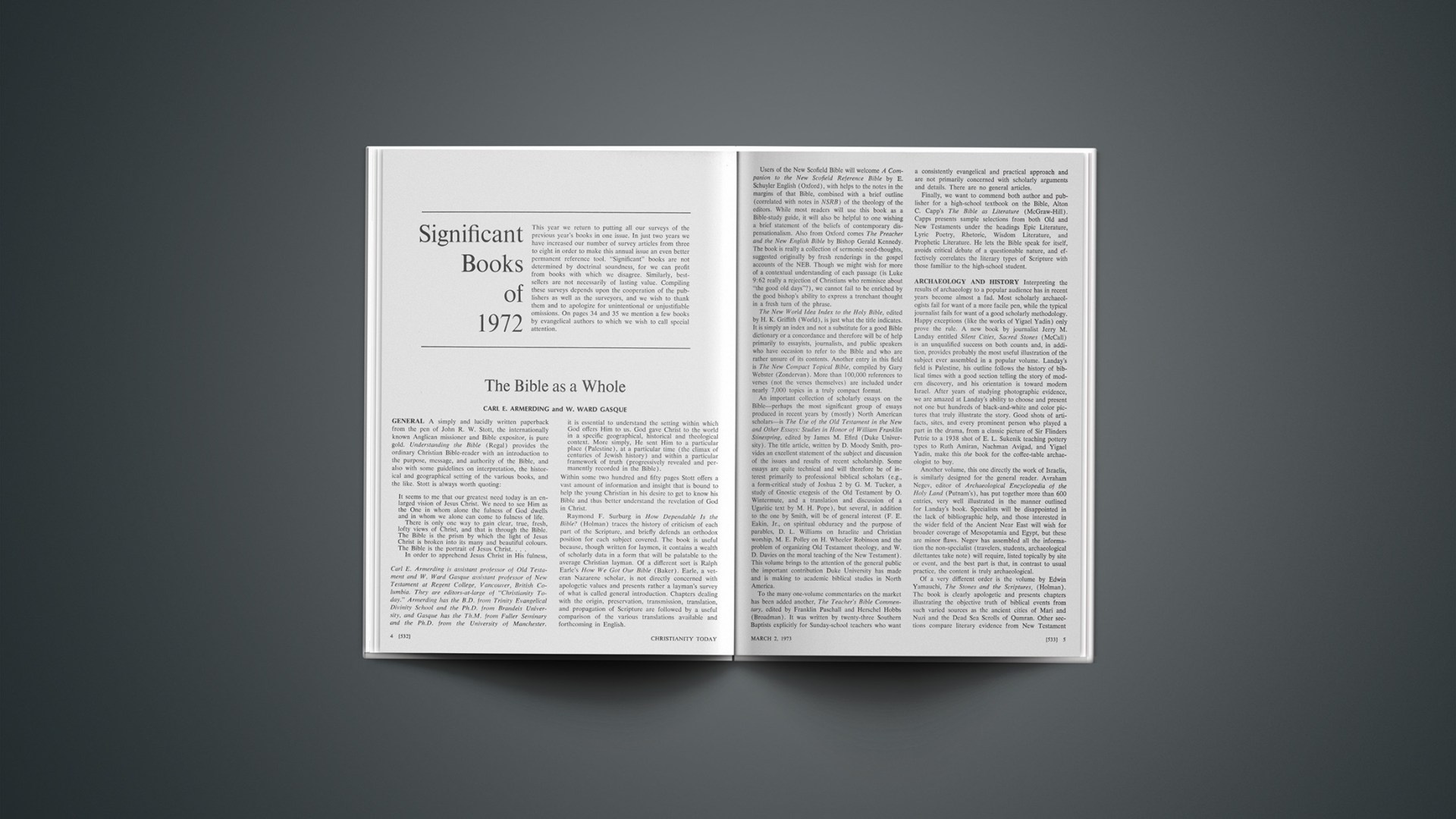GENERAL A simply and lucidly written paperback from the pen of John R. W. Stott, the internationally known Anglican missioner and Bible expositor, is pure gold. Understanding the Bible (Regal) provides the ordinary Christian Bible-reader with an introduction to the purpose, message, and authority of the Bible, and also with some guidelines on interpretation, the historical and geographical setting of the various books, and the like. Stott is always worth quoting:
It seems to me that our greatest need today is an enlarged vision of Jesus Christ. We need to see Him as the One in whom alone the fulness of God dwells and in whom we alone can come to fulness of life.
There is only one way to gain clear, true, fresh, lofty views of Christ, and that is through the Bible. The Bible is the prism by which the light of Jesus Christ is broken into its many and beautiful colours. The Bible is the portrait of Jesus Christ.…
In order to apprehend Jesus Christ in His fulness, it is essential to understand the setting within which God offers Him to us. God gave Christ to the world in a specific geographical, historical and theological context. More simply, He sent Him to a particular place (Palestine), at a particular time (the climax of centuries of Jewish history) and within a particular framework of truth (progressively revealed and permanently recorded in the Bible).
Within some two hundred and fifty pages Stott offers a vast amount of information and insight that is bound to help the young Christian in his desire to get to know his Bible and thus better understand the revelation of God in Christ.
Raymond F. Surburg in How Dependable Is the Bible? (Holman) traces the history of criticism of each part of the Scripture, and briefly defends an orthodox position for each subject covered. The book is useful because, though written for laymen, it contains a wealth of scholarly data in a form that will be palatable to the average Christian layman. Of a different sort is Ralph Earle’s How We Got Our Bible (Baker). Earle, a veteran Nazarene scholar, is not directly concerned with apologetic values and presents rather a layman’s survey of what is called general introduction. Chapters dealing with the origin, preservation, transmission, translation, and propagation of Scripture are followed by a useful comparison of the various translations available and forthcoming in English.
Users of the New Scofield Bible will welcome A Companion to the New Scofield Reference Bible by E. Schuyler English (Oxford), with helps to the notes in the margins of that Bible, combined with a brief outline (correlated with notes in NSRB) of the theology of the editors. While most readers will use this book as a Bible-study guide, it will also be helpful to one wishing a brief statement of the beliefs of contemporary dispensationalism. Also from Oxford comes The Preacher and the New English Bible by Bishop Gerald Kennedy. The book is really a collection of sermonic seed-thoughts, suggested originally by fresh renderings in the gospel accounts of the NEB. Though we might wish for more of a contextual understanding of each passage (is Luke 9:62 really a rejection of Christians who reminisce about “the good old days”?), we cannot fail to be enriched by the good bishop’s ability to express a trenchant thought in a fresh turn of the phrase.
The New World Idea Index to the Holy Bible, edited by H. K. Griffith (World), is just what the title indicates. It is simply an index and not a substitute for a good Bible dictionary or a concordance and therefore will be of help primarily to essayists, journalists, and public speakers who have occasion to refer to the Bible and who are rather unsure of its contents. Another entry in this field is The New Compact Topical Bible, compiled by Gary Webster (Zondervan). More than 100,000 references to verses (not the verses themselves) are included under nearly 7,000 topics in a truly compact format.
An important collection of scholarly essays on the Bible—perhaps the most significant group of essays produced in recent years by (mostly) North American scholars—is The Use of the Old Testament in the New and Other Essays: Studies in Honor of William Franklin Stinespring, edited by James M. Efird (Duke University). The title article, written by D. Moody Smith, provides an excellent statement of the subject and discussion of the issues and results of recent scholarship. Some essays are quite technical and will therefore be of interest primarily to professional biblical scholars (e.g., a form-critical study of Joshua 2 by G. M. Tucker, a study of Gnostic exegesis of the Old Testament by O. Wintermute, and a translation and discussion of a Ugaritic text by M. H. Pope), but several, in addition to the one by Smith, will be of general interest (F. E. Eakin, Jr., on spiritual obduracy and the purpose of parables, D. L. Williams on Israelite and Christian worship, M. E. Polley on H. Wheeler Robinson and the problem of organizing Old Testament theology, and W. D. Davies on the moral teaching of the New Testament). This volume brings to the attention of the general public the important contribution Duke University has made and is making to academic biblical studies in North America.
To the many one-volume commentaries on the market has been added another, The Teacher’s Bible Commentary, edited by Franklin Paschall and Herschel Hobbs (Broadman). It was written by twenty-three Southern Baptists explicitly for Sunday-school teachers who want a consistently evangelical and practical approach and are not primarily concerned with scholarly arguments and details. There are no general articles.
Finally, we want to commend both author and publisher for a high-school textbook on the Bible, Alton C. Capp’s The Bible as Literature (McGraw-Hill). Capps presents sample selections from both Old and New Testaments under the headings Epic Literature, Lyric Poetry, Rhetoric, Wisdom Literature, and Prophetic Literature. He lets the Bible speak for itself, avoids critical debate of a questionable nature, and effectively correlates the literary types of Scripture with those familiar to the high-school student.
ARCHAEOLOGY AND HISTORY Interpreting the results of archaeology to a popular audience has in recent years become almost a fad. Most scholarly archaeologists fail for want of a more facile pen, while the typical journalist fails for want of a good scholarly methodology. Happy exceptions (like the works of Yigael Yadin) only prove the rule. A new book by journalist Jerry M. Landay entitled Silent Cities, Sacred Stones (McCall) is an unqualified success on both counts and, in addition, provides probably the most useful illustration of the subject ever assembled in a popular volume. Landay’s field is Palestine, his outline follows the history of biblical times with a good section telling the story of modern discovery, and his orientation is toward modern Israel. After years of studying photographic evidence, we are amazed at Landay’s ability to choose and present not one but hundreds of black-and-white and color pictures that truly illustrate the story. Good shots of artifacts, sites, and every prominent person who played a part in the drama, from a classic picture of Sir Flinders Petrie to a 1938 shot of E. L. Sukenik teaching pottery types to Ruth Amiran, Nachman Avigad, and Yigael Yadin, make this the book for the coffee-table archaeologist to buy.
Another volume, this one directly the work of Israelis, is similarly designed for the general reader. Avraham Negev, editor of Archaeological Encyclopedia of the Holy Land (Putnam’s), has put together more than 600 entries, very well illustrated in the manner outlined for Landay’s book. Specialists will be disappointed in the lack of bibliographic help, and those interested in the wider field of the Ancient Near East will wish for broader coverage of Mesopotamia and Egypt, but these are minor flaws. Negev has assembled all the information the non-specialist (travelers, students, archaeological dilettantes take note) will require, listed topically by site or event, and the best part is that, in contrast to usual practice, the content is truly archaeological.
Of a very different order is the volume by Edwin Yamauchi, The Stones and the Scriptures, (Holman). The book is clearly apologetic and presents chapters illustrating the objective truth of biblical events from such varied sources as the ancient cities of Mari and Nuzi and the Dead Sea Scrolls of Qumran. Other sections compare literary evidence from New Testament times with the figure of Christ in the Gospels and attack certain forms of criticism for ignoring this evidence. But finally, Yamauchi concludes, archaeology, which can show us only artifacts, can never be a substitute for a personal faith in the living God. Such a God can never be subjected to the scrutiny of a mere archaeological spade.
Two further books deserve mention. Almost half of the Hebrew Union College Annual: Volume XLII, is devoted to an article by E. K. Vogel entitled “Bibliography of Holy Land Sites.” Miss Vogel has produced the definitive work on the subject, and we can only hope her work will be carried on into the areas beyond Palestine. Far less important for research but nevertheless of interest is the reissue of Harry M. Orlinsky’s 1954 book Ancient Israel in an expanded format under the title Understanding the Bible Through History and Archaeology (Ktav). The original text, printed on the left-hand page, is accompanied by extensive biblical quotations on the right, with parallel columns in Hebrew and English. Some very useful illustrations round out the volume, which will be especially helpful to a popular Jewish audience (“Bible” for Orlinsky stops with Malachi).
A specialty study intended for traveler as well as armchair archaeologist is G. Frederick Owen’s Jerusalem (Baker). Owen includes chapters on the Holy City’s valleys, its hills, its walls, and its gates and streets. The book is inspirational and often helpful, but suffers from a lack of up-to-date information (there is now less question about the location of the north wall in Jesus’ time than Owen would admit) or theological bias (there is no need to try to preserve the uniqueness of divine revelation by denying Phoenician influence in Solomon’s temple). An enthusiastic personal reminiscence by Lowell Thomas forms the introduction.
Moving to the field of history (see also specific articles on Old and New Testament), we note the arrival of volume six in Rutgers’s World History of the Jewish People. This volume, edited by Abraham Schalit and entitled The Hellenistic Age, is slightly disappointing for a major new work and would not, by itself, be the recommended text on the period 332–67 B.C. However, as a part of a major and exciting new series, the work provides adequate if uninspired coverage of an important formative period in Judaism.
BIBLICAL THEOLOGY With the publication of volume eight of G. W. Bromiley’s English translation, the famous Theological Dictionary of the New Testament, edited by G. Kittel and G. Friedrich (Eerdmans), nears completion. The present volume covers the letters tau and upsilon and is smaller than earlier volumes (only 620 pages!). Twenty-four contributors write on forty-one words and word-groups that are important for a theological understanding of the Bible. Despite the work’s title, much material on the Old Testament is included. Among the important articles are long essays on “son” and “sonship” (by five authors), “the Son of Man” (C. Colpe), and the “Son of David” (E. Lohse). No one interested in “the theology of prepositions” will want to miss Harald Riesenfeld’s study of hyper.
That good things come in small packages has repeatedly been proven by Fortress Press with its “Facet” series. This year’s offering, Beginning and End in the Bible by Claus Westermann, is no exception. The author, a prominent German form critic and Genesis scholar, challenges O. Cullmann’s contention that beginning and end are simply historical events on the time line of human salvation-history. Rather, because the biblical language differs so in discussing the two events (the study covers Genesis 1–11 and Revelation), we are led to the conclusion that in creation and fulfillment God is doing something vastly greater than simply dealing with man in salvation. Westermann would have us see this greater thing as a cosmic, universal event, one no more limitable to earth and its categories than God himself would be. And in fact, claims Westermann, it is God himself, as the Alpha and the Omega, the Utterly Transcendent one, who is the key to both beginning and end.
A second biblical-theological monograph, The Old Law and the New Law by William Barclay (Westminster), is really a popular exposition of the Ten Commandments and the Sermon on the Mount. As usual, there is help for the preacher who is concerned with getting the message across to the congregation and also for the general reader who simply wishes to understand.
Turning specifically to studies dealing with the end time, we are treated to two books on the current state of research into that branch of eschatology called “apocalyptic.” Because the subject forms a bridge between Old and New Testament studies, these volumes are of interest to students of both. Perhaps the best place to begin is with Leon Morris’s introductory study, Apocalyptic (Eerdmans), a book in which the background and development of apocalyptic in the intertestamental period is traced. Morris rightly rejects the extreme view of E. Kasemann and others that apocalyptic is “the mother of all Christian theology,” though many will feel his limitation of apocalyptic to “the background of the New Testament message” too severe. A second volume, The Rediscovery of Apocalyptic by Klaus Koch (SCM), is primarily a critical survey of recent European discussion of the subject, particularly in the work of New Testament scholars. Koch contends that insufficient attention has been paid to the texts themselves; this, coupled with a faulty historical methodology, has led to a negative reaction that can only do harm in the long run. Koch and Morris (who is part of the reaction) express just two of the many positions being ventilated on the subject today, but their works provide a good starting point for understanding the rest.
CANON Teachers of biblical studies and historical theology alike will be grateful to Fortress for making available in English Hans von Campenhausen’s The Formation of the Christian Bible. The author’s study of the formation of both Old and New Testament canons is set in the context of the history of the Church during its first three centuries. All will find this volume illuminating, though many will question some of the conclusions.
Two more specialized monographs, written from vastly differing perspectives, take their places in the continuing debate about canon. Both attempt to move the discussion back from the traditional arguments about Jamnia to the time the concept of canon was formulated, but there the similarity ends. In The Structure of Biblical Authority (Eerdmans) Meredith G. Kline builds on his earlier studies of the structure of covenant or treaty law as found in Deuteronomy, and concludes that one of the functions of the covenant form was to give immediate canonicity to the document in question. Just as a Hittite treaty had immediate authority when promulgated, so the various parts of the Torah had immediate authority.
A second book, Torah and Canon (Fortress) by James A. Sanders, likewise investigates the function of canonicity and finds its origin in the early post-exilic community, which, facing its own potential nonbeing, responded to its old traditions in such a way that the traditions became the basis for a new and living Torah. With Sanders, the ultimate source of this authority is in communal recognition; with Kline, the ultimate source of authority is the God who, as Great King, established covenant with Israel. Both works are provocative, both present a fresh approach to an important question (though much of Kline’s work has appeared elsewhere), and both deserve widespread attention.
George M. Marsden is associate professor of history at Calvin College, Grand Rapids, Michigan. He has the Ph.D. (Yale University) and has written “The Evangelical Mind and the New School Presbyterian Experience.”










